AI-Powered Semi-Autonomous Trains: Revolutionizing Rail Safety

Introduction
The railway industry is undergoing a significant transformation driven by advancements in artificial intelligence (AI) and the pursuit of enhanced safety and operational efficiency. This article explores the recent introduction of semi-autonomous capabilities for locomotives by Rail Vision, a leading provider of railway safety technology. This development marks a pivotal shift from passive warning systems to active control, ushering in a new era of advanced driver-assistance systems (ADAS) for the rail sector. The implications of this technology are far-reaching, impacting safety protocols, operational costs, and the overall evolution towards fully autonomous rail operations. We will delve into the technical aspects of Rail Vision’s system, its integration with existing infrastructure, the anticipated benefits for railway operators, and the broader context of this innovation within the Intelligent Transportation Systems (ITS) market. This examination will reveal not only the immediate impact of this technology but also its potential to reshape the future of railway operations globally.
Semi-Autonomous Locomotive Control: A Technological Leap
Rail Vision’s new system represents a substantial advancement in railway safety technology. Unlike passive warning systems that simply alert the operator to potential hazards, this system actively controls the locomotive’s throttle and brakes. This active control is achieved through the integration of advanced AI algorithms which process real-time data from various sensors. The system’s AI engine analyzes this data, identifying potential obstacles such as humans, animals, vehicles, or track defects, and initiates the necessary corrective actions to prevent collisions. The seamless integration with existing shunter control systems minimizes disruption to existing operational workflows and maximizes operator acceptance. This proactive approach significantly reduces the reliance on human reaction time, a critical factor in preventing accidents. The system’s real-time response capability ensures that immediate and effective actions are taken to mitigate risks, ultimately enhancing safety and operational continuity.
AI-Powered Obstacle Detection and Collision Avoidance
Central to Rail Vision’s technology is its sophisticated AI-powered obstacle detection system. This system utilizes a combination of computer vision and machine learning techniques to accurately identify and classify potential hazards. The AI engine continuously monitors the track environment, analyzing data from various sensors, including cameras and LiDAR (Light Detection and Ranging), to build a comprehensive understanding of the surrounding area. This detailed analysis allows the system to distinguish between static and dynamic objects, enabling precise predictions of potential collision events. Upon detecting a potential hazard, the system generates both visual and acoustic alerts for the train’s command-and-control center and, crucially, initiates autonomous braking and throttle adjustments to prevent a collision. This multifaceted approach combines advanced AI processing with immediate corrective action.
Integration and Deployment: A Seamless Transition
The successful implementation of Rail Vision’s semi-autonomous system relies on its seamless integration with existing railway infrastructure and locomotive control systems. The design philosophy prioritizes minimizing disruption to existing operational processes and ensuring a smooth transition for railway operators. The system is designed to complement existing controls, providing an assistive layer of automated safety and efficiency enhancements. This approach avoids costly and disruptive overhauls of existing systems and allows for a phased implementation, minimizing operational downtime. Initial deployment is scheduled for the end of 2024 on a major US rail fleet, demonstrating the practical viability and scalability of the technology. The successful integration of the system into a real-world operational environment will further validate its effectiveness and pave the way for broader adoption across the rail industry.
Conclusion
Rail Vision’s introduction of semi-autonomous capabilities for locomotives marks a significant milestone in the evolution of railway technology. By actively controlling the throttle and brakes using AI-powered obstacle detection and collision avoidance, the system offers a substantial improvement in safety and operational efficiency. The system’s seamless integration with existing infrastructure minimizes disruption and promotes wider adoption. The move from passive warning systems to active control represents a transformative leap in ADAS (Advanced Driver Assistance Systems) for the rail sector. The successful initial deployment in late 2024 on a major US rail fleet underscores the technology’s maturity and practical applicability. The benefits extend beyond enhanced safety; improved operational efficiency and reduced operational costs also contribute to the system’s overall value proposition. The long-term implications are profound, paving the way for greater automation in railway operations and potentially contributing to the development of fully autonomous trains. While safety remains the paramount concern, the economic benefits of increased efficiency and reduced accident-related costs are also substantial. This innovation represents a significant step towards a safer, more efficient, and technologically advanced future for the railway industry globally.






